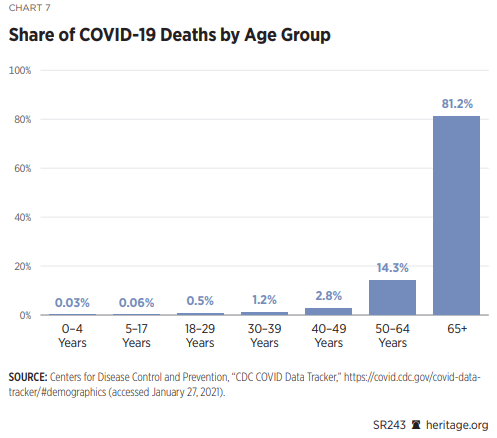Infection Fatality Rate
In February 2020 the predictions of the Infection Fatality Rate (IFR), or “death rate” from COVID were estimated by the World Health Organization (WHO) to be 3.4%.[1] We were told that COVID was much more deadly than the seasonal flu and we must “flatten the curve” to avoid collapsing hospitals. [2] Seven months later, the WHO acknowledges in its report that “infection fatality rates tended to be much lower than estimates made earlier in the pandemic.”[3] The WHO’s report found that the “median COVID infection fatality rate was 0.27%”.[4] Other studies support this finding with IFRs of 0.01%-0.32%. By comparison, the flu has an IFR of 0.1%-0.2%, making it more deadly than COVID in many cases.[5][6]
Chief Medical Officer of the UK, Chris Whitty acknowledged COVID's "low mortality rate" when he recommended against fast-tracking vaccine approvals in February 2020 according to files revealed three years later.[7]
IFR and age
Discussion of an IFR for COVID is somewhat simplistic since the IFR varies dramatically and increases with age. This point makes the one-size-fits-all public health policies such as universal masking, lockdowns, and vaccinations especially inappropriate.
"The IFR was very low among people younger than 51 years without comorbidity during the 2 waves (combined IFR=3.36 per 100000 infections). The IFR increased with age (281 per 100000 for people aged 61 to 69 years without comorbidity)." And that "IFR increased with age and comorbidity but declined from the first to second wave." [8]
"The estimated age-specific IFR is very low for children and younger adults (e.g., 0.002% at age 10 and 0.01% at age 25) but increases progressively to 0.4% at age 55, 1.4% at age 65, 4.6% at age 75, and 15% at age 85." [9]
“The median IFR was 0.0003% at 0-19 years, 0.003% at 20-29 years, 0.011% at 30-39 years, 0.035% at 40-49 years, 0.129% at 50-59 years, and 0.501% at 60-69 years. The current analysis suggests a much lower pre-vaccination IFR in non-elderly populations than previously suggested.” [10]

https://www.heritage.org/sites/default/files/2021-03/SR243.pdf (page 13)

https://www.heritage.org/sites/default/files/2021-03/SR243.pdf (page 12)
Footnotes:
[1] “WHO says coronavirus death rate is 3.4% globally”
[2] “A flatter curve, on the other hand, assumes the same number of people ultimately get infected, but over a longer period of time”
https://www.livescience.com/coronavirus-flatten-the-curve.html
[3] “The inferred infection fatality rates tended to be much lower than estimates made earlier in the pandemic”
[4] “median COVID-19 infection fatality rate was 0.27%”
[5] “coronavirus might not be as deadly as flu”
[6] "The overall clinical consequences of Covid-19 may ultimately be more akin to those of a severe seasonal influenza (which has a case fatality rate of approximately 0.1%) or a pandemic influenza (similar to those in 1957 and 1968) rather than a disease similar to SARS or MERS, which have had case fatality rates of 9 to 10% and 36%, respectively.2"
https://www.nejm.org/doi/full/10.1056/nejme2002387
[7] https://www.telegraph.co.uk/news/2023/03/07/covid-not-deadly-enough-fast-track-vaccines-chris-whitty-advised/
[8] https://www.ncbi.nlm.nih.gov/pmc/articles/PMC8689980/
[9] https://link.springer.com/article/10.1007/s10654-022-00853-w
[10] https://www.medrxiv.org/content/10.1101/2022.10.11.22280963v1
Email questions or comments to frontlinepedia@aflds.org
